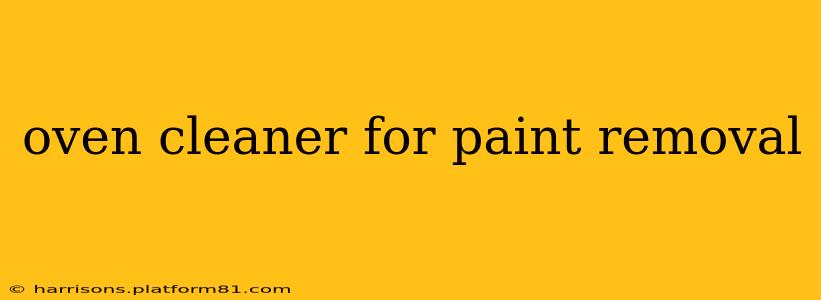Oven cleaner is a powerful chemical designed to cut through baked-on grease, and its strong caustic properties can also strip paint. However, using oven cleaner for paint removal is a double-edged sword. While effective, it's also extremely dangerous if not handled correctly. This article will explore the effectiveness, safety concerns, and best practices when considering this method.
Is Oven Cleaner Effective at Removing Paint?
Yes, oven cleaner can effectively remove paint, particularly older, brittle layers. The strong alkaline chemicals in most oven cleaners break down the paint's binder, causing it to soften and blister, making it easier to scrape off. It's especially effective on oil-based paints. However, it's less effective on newer, durable paints or those with multiple coats. The effectiveness also varies depending on the type of paint, the surface being cleaned, and the specific oven cleaner used.
What are the Safety Concerns of Using Oven Cleaner to Remove Paint?
Using oven cleaner for paint removal presents significant safety risks:
- Harmful Fumes: Oven cleaners release highly toxic fumes that can irritate the eyes, nose, and throat. Prolonged exposure can lead to more serious health problems. Always work in a well-ventilated area, ideally outdoors.
- Skin Burns: The caustic chemicals in oven cleaner can cause severe burns on contact with skin. Wear heavy-duty rubber gloves, eye protection, and long sleeves and pants.
- Surface Damage: Oven cleaner can damage certain surfaces, including some plastics and metals. Test it in an inconspicuous area first to check for compatibility.
- Environmental Impact: Oven cleaner is a harsh chemical and should be disposed of properly according to local regulations.
What Types of Paint Can Be Removed With Oven Cleaner?
Oven cleaner is most effective on oil-based paints and older, flaking paint. It may be less effective, or even ineffective, on:
- Water-based paints (latex): These paints often have a different chemical composition that may not be as easily broken down by oven cleaner.
- Modern, durable paints: Newer paints are often formulated to be more resistant to chemicals.
- Epoxy paints: These are extremely durable and resist most chemicals.
How to Safely Use Oven Cleaner for Paint Removal (If You Choose This Method):
Caution: This method is strongly discouraged unless you have extensive experience working with harsh chemicals. If you proceed, prioritize safety:
- Ventilation: Work outdoors or in a very well-ventilated area with good air circulation.
- Protective Gear: Wear heavy-duty rubber gloves, eye protection (safety glasses or a face shield), and protective clothing that covers your skin completely.
- Test Area: Apply a small amount of oven cleaner to an inconspicuous area to check for compatibility and effectiveness.
- Application: Apply a thin, even layer of oven cleaner to the painted surface, avoiding over-application.
- Dwell Time: Allow the cleaner to dwell according to the manufacturer's instructions, typically 15-30 minutes. Never exceed the recommended dwell time.
- Removal: Use a putty knife or scraper to remove the softened paint. Wipe away residue with a damp cloth.
- Cleaning: Thoroughly clean the area with soap and water.
- Disposal: Dispose of the used oven cleaner and cleaning materials properly according to local regulations.
Are There Safer Alternatives to Oven Cleaner for Paint Removal?
Yes, there are significantly safer alternatives for paint removal, including:
- Paint scrapers: Effective for removing loose or flaking paint.
- Heat guns: Soften paint for easier removal, but requires caution to avoid fire hazards.
- Chemical paint strippers: Specifically designed for paint removal and offer varying levels of toxicity. Always follow the manufacturer's safety instructions.
- Sandblasting: A powerful method, but requires specialized equipment and safety precautions.
What if I Get Oven Cleaner on My Skin?
Immediately flush the affected area with plenty of cool water for at least 15-20 minutes. Remove any contaminated clothing. Seek medical attention if irritation or burning persists.
In conclusion, while oven cleaner can remove paint, its hazardous nature makes it a risky option. Safer alternatives exist and should be considered first. If you choose to use oven cleaner, prioritize safety above all else. Always read and follow the manufacturer's safety instructions meticulously.
